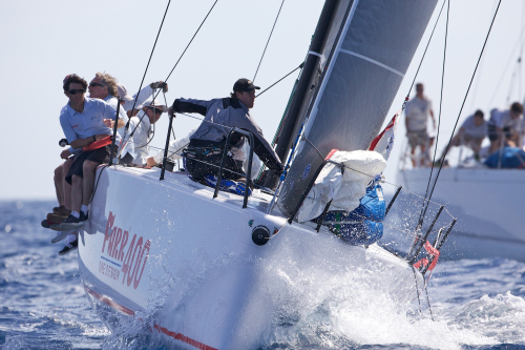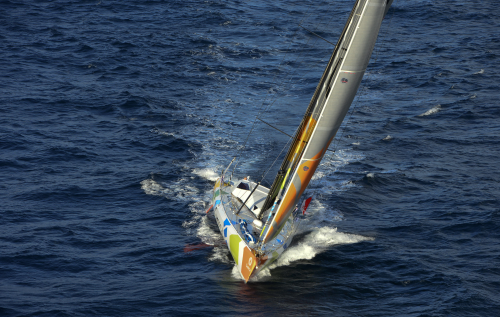
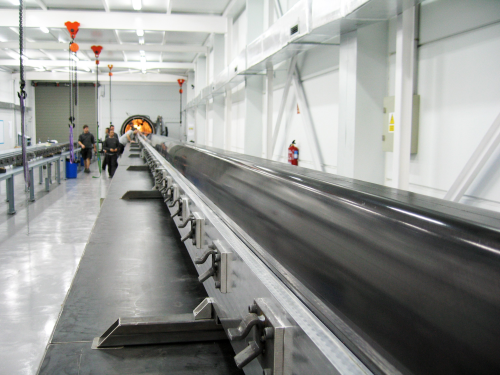
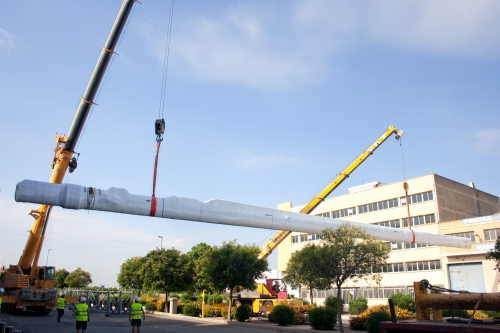
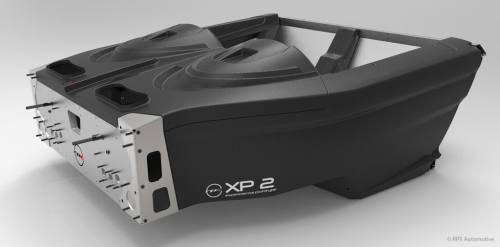
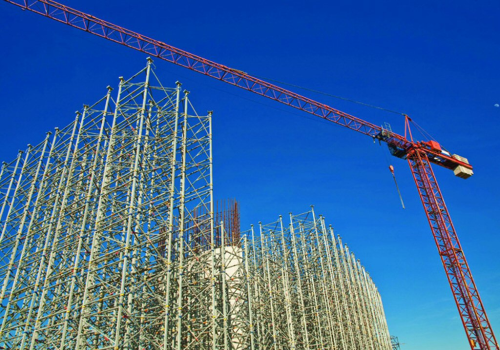
.jpg) Future Fibres' roots lie in the composite rigging business. The company's founder Tom Hutchinson pioneered the development of continuously wound, unidirectional fibre cables for rigging in 1996/97. Future Fibres has continued to develop this technology, believing that it provides the best fibre alignment and load sharing of any composite cable production technology, resulting in the highest cable performance in terms of strength and weight for a given stretch.
Future Fibres' roots lie in the composite rigging business. The company's founder Tom Hutchinson pioneered the development of continuously wound, unidirectional fibre cables for rigging in 1996/97. Future Fibres has continued to develop this technology, believing that it provides the best fibre alignment and load sharing of any composite cable production technology, resulting in the highest cable performance in terms of strength and weight for a given stretch.
Today, the company's cable range comprises side shrouds, tortional code stays, furling forestays, fixed forestays, aft rigging and strops, and more. As well as a range of standard sizes, Future Fibres is able to manufacture cables to any given stretch equivalent, working load or diameter.
The right rigging
Future Fibres has developed bespoke CNC winding technology. A single thread of fibre is taken from large individual fibre spools, held at a controlled tension, and wound continuously around two end terminations set at the required distance apart (the cable length) until the desired fibre content has been achieved. This creates a simple fibre loop which is inherently safe and strong.
This fibre loop bundle is then consolidated using tape layers to minimise diameter and provide environmental protection. A braided cover is added for chafe resistance. The fibre loops around the end terminations are then encapsulated in resin to seal the fibre from the elements and create a flexible transition between the termination and the dry fibre cable core.
A key advantage of this technology is that there is no need for any termination or mechanical link to transfer the load from the cable to the deck/mast. Whilst the cable can be supplied as a 'soft loop,' metal spools are generally used to increase longevity and ease of interface.
Future Fibre focuses on suppying 'the right fibre for the right application.’ It points out that the 'right' fibre will depend on the cable application (laterals, forestays, torsionals, running aft), and the type of programme programme (GP race, racing superyacht, cruising superyacht etc.).
The company's fibre range comprises:
- PBO (poly(p-phenylene-2,6-benzobisoxazole) fibre, which has extremely high mechanical properties yet is quite flexible;
- Dyneema®, a high-performance polyethylene (HPPE) fibre, which produces a heavier, larger diameter cable than PBO for the same stretch;
- Kevlar® aramid fibre, the forerunner to PBO, which shares many of its properties but cannot compete with it on strength, modulus and weight; and
- carbon fibre.
Future Fibres' solid carbon fibre rigging, sold under the ThermoSet Carbon (TSC) name, offers a weight and diameter advantage over PBO. It's the result of 12 years of development, optimising fibre performance with the latest epoxy resin technology. To produce the cables carbon fibre prepreg tow is wound around titanium spools (in the same way as the traditional dry fibre construction described above), then taped to consolidate it, cured and finished. The result is a solid, circular section, carbon fibre rod. This simply requires a painted/lacquered finish for UV protection.
The downside of carbon fibre rigging is its poor flexibility, which limits its applicability for certain cable types. Recognising this, Future Fibres R&D set out to build a flexible carbon cable, which is calls FlexC™. This uses a custom carbon fibre which is impregnated with a specially designed epoxy matrix, allowing complete control of the quality and finish. The impregnated fibre tow is wound, consolidated and covered with a braid layer for chafe protection.
Future FIibres claims its FlexC cables combine all the benefits of carbon fibre (stiffness, strength and excellent fatigue resistance) with the flexibility, impact resistance and general handling benefits of a dry fibre cable. FlexC has undergone an extensive test programme with a number of development partners (including Open 60/Volvo 70 projects), clocking up over 400,000 sea miles before market launch.
Future Fibres boasts an onsite 50 m certified test bed and Germanischer Lloyd (GL) Type Approval for its PBO and carbon technologies.
Big projects
Building on its expertise in the composite rigging market, in 2010 Future Fibres created a mast division, with the aim of manufacturing high performance carbon fibre masts, booms, spreaders and custom components. Its partner in this business is tooling specialist Persico SpA, headquartered in Italy.
These are big projects. 10,000 m2 of Future Fibres’ 15,000 m2 facility in Valencia is dedicated to the mast business. An impressive array of equipment includes:
- a 50 m x 1.5 m autoclave;
- 60 m climate-controlled laminate and paint booths;
- a 70 m assembly and fit-out area; and
- a machine shop.
Mast tube and spreaders are produced from prepreg, laid up by hand in female aluminium moulds. They are cured in the autoclave with 3-6 bars of pressure at 100-120°C. The high precision tooling significantly reduces the amount of finishing required, reducing and optimising tube weight.
At the time of Reinforced Plastics visit, work was in progress on a 76 m long mast, as well as several furling booms of more than 25 m in length.
The 76 m mast, for a 60 m Perini Navi sloop, was completed in September following almost 18 months in design, development and construction. Future Fibres will also supply the furling boom and bespoke composite rigging package for the boat.
|
Bringing the innovations we’ve developed for the race market to a superyacht of this size certainly represented a challenge. We invested a tremendous amount of time into the design and management of the project to ensure we understood every variable down to the smallest detail and we are very pleased with the outcome. |
| Tim Meldrum, Future Fibres' Chief Designer |
The brief for this vessel, designated C.2218 (and scheduled for delivery in 2014), focused on achieving the highest levels of performance and meant Future Fibres was able to utilise developments from its work in the Grand Prix arena. Using its milled aluminium tooling Future Fibres managed to produce a mast tube with a near perfect exterior surface and a flawless Clearcote gloss finish. The elimination of filler – which can add up to 3% to the weight of a mast – further reduces unnecessary weight.
Utilising Future Fibres’ 40 m clean room/oven meant the 23.4 m furling boom could be manufactured using carbon fibre prepreg, rather than standard wet laminate, improving structural performance and again, reducing weight.
Future Fibres believes that there are opportunities for significant improvements to be made within the spar and rigging industry. One is design software. Much of what is in use today has evolved from aluminium mast design and does not allow for the fact the tube is a composite laminate.
Future Fibres uses a Catia-Abaqus platform specifically designed for use with composite structures and proven in the aerospace world as the core design software for Airbus and Boeing. It has also developed its own bespoke software, MasterMind Pro, for optimised mast design. This allows designers to run multiple laminate and patching scenarios, in real time, to optimise tube design.
Beyond the sea
|
At Future Fibres we are pushing our understanding of the structural implications of defects and damage in composite parts and focusing on the development of new materials in terms of performance and functionality. One area in which we are seeing this development is with our current work on integrated sensors. Here we are testing the use of nanotube-base composites as conductive textiles to monitor the health status of our parts, and then using our findings to make decisions on repair or substitution. |
| Luca Mezzo, CTO, Future Fibres |
Future Fibres has been growing and it now employs over 100 people. It is planning to grow further by ultilising its background in engineering composites for use in extreme marine environments in other markets. Over recent years personnel from other industries like motorsport and aerospace has been recruited to enable this growth. Luca Mezzo, previously with aerospace specialist Safran, has taken up the new position of Chief Technology Officer, and to separate day-to-day R&D (product enhancements) from 'true innovation' the company recently set up an Innovation Centre in the UK.
Future Fibres believes applications which could benefit from its composites expertise include:
- automotive: the company has already produced carbon safey tethers for the wheels on F1 cars, and it's working with UK company RPx Automotive on the carbon composite tub of its new race car, codenamed RP-one (see picture on right);
- civil engineering: Future Fibres provided solid carbon fibre cables as the primary load-bearing supports for a 216 m long, 3 m wide footbridge in Spain, enabling reduced installation time and cost;
- lifting technology: the replacement of metal cables with lightweight composite cables on cranes and other lifting equipment can result in benefits including a 70-90% weight reduction, improved fatigue resistance, longer cable life and reduced maintenance; and
- oil and gas: the exploitation of deepwater oil and gas reserves will require lightweight cable technology.
New directions
The move from the large, one-off, custom projects it currently specialises in, to higher volume products, is the challenge Future Fibres now faces.
“Volume markets will require the capacity to manufacture high-quality, standardised products for global delivery," Tom Hutchinson explains.
"We have worked extremely hard to achieve optimum efficiency in our manufacturing processes and this will be a crucial factor to our success in this sector.” ♦
Also see:
- Future Fibres composite mast passes Vendée Globe challenge;
- Blog: Future Fibres: moving beyond marine.
This article will be published in the November/December 2013 issue of Reinforced Plastics magazine.
The digital edition of Reinforced Plastics is distributed free of charge to readers who meet our qualifying criteria. You can apply to receive your free copy by completing the registration form.
Reinforced Plastics is also available on ScienceDirect, Elsevier's full-text scientific database offering journal articles and book chapters from more than 2,500 journals and almost 20,000 books.



